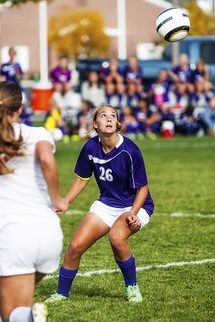We are often reminded that life is not measured by the number of times we fall down, but by the number of times we pick ourselves up. No one, perhaps, knows this better than an athlete.
The benefits of sports have been well understood for years. Athletics, quite simply, build character. They teach us valuable lessons about leadership, teamwork and resolve, and they help us develop critical thinking skills. Victories and defeats force us to see the world differently, and our experiences shape the people we become.
Injuries come with the territory. Bruises, scars and horror stories are as important to an athlete's narrative as game-winning plays, medals and titles. But broken bones heal, and bruises fade.
We may never recover from a blow to the head. If we sustain a concussion, our worldview may change, but in negative, irreversible ways.
Unfortunately the rate of concussions among athletes is trending in the wrong direction. Every three minutes, a child is treated for a sports-related concussion. Twelve percent of all emergency room visits among children ages 6 to 19 each year involve a concussion, with basketball, cheerleading, football and soccer accounting for most incidents. An estimated 3.8 million athletes are concussed each year, but the Brain Trauma Foundation believes concussions are underreported and underdiagnosed.
Decades ago, it wasn't uncommon for coaches, players and parents to dismiss blows to the head. It was generally accepted that you would "get your bell rung" from time to time. We did not realize, of course, how irresponsible that mindset was. Concussions change the white matter in our brains. Even if they are treated, they can have serious - and sometimes permanent - side effects, including:
•Headaches
•Dizziness
•Nausea
•Changes in vision
•Sensitivity to light and/or noise
•Changes in behavior, including with moods and sleep
•Confusion about basic information, such as the day of the week
•Anxiety
•Depression
•Suicidal thoughts
The uptick in concussions has sparked an important national conversation, involving everyone from parents to athletes to doctors to NFL executives. This dialog has led to better education, development of prevention programs and safety improvements to equipment. Virginia Tech, for example, provides helmet ratings so consumers can make informed decisions before purchasing. Although helmets are required to meet minimum safety standards, we know as safety professionals that standards are the floor - not the ceiling. We should always strive for better, especially when it comes to our well-being.
Helmet ratings are overdue. We rate the vehicles we drive in, the household products we use - even the food we feed to our pets. Evaluating products that protect the most important part of our bodies is not only prudent, but also potentially lifesaving. I encourage anyone who plays either football or hockey to check your helmet against Virginia Tech's ratings. Don't skimp on safety. If you need to make adjustments, do so.
Because the concussion epidemic is so important, the National Safety Council will continue exploring the complexity of the issue, the nature of the injuries and the advancements being made by organizations such as Virginia Tech. I hope you will check back for future posts about concussions among girls versus boys, the efficacy of concussion prevention programs, and the importance of protecting your head when you are riding a bike - not just taking hits on the field or the ice.
By continuing the dialog, hopefully a fall is just a footnote in an athlete's story - not the story itself.
*Deborah Hersman is president and CEO of the National Safety Council

